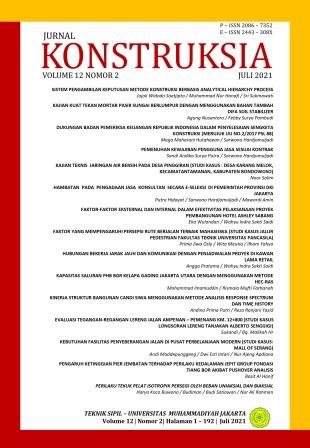PENGARUH KETINGGIAN PIER JEMBATAN TERHADAP PERILAKU KEDALAMAN JEPIT GROUP FONDASI TIANG BOR AKIBAT PUSHOVER ANALISIS
DOI:
https://doi.org/10.24853/jk.12.2.174-183Keywords:
Kekakuan, Ketinggian Pier Jembatan, Pushover analisis, Respon Tiang FondasiAbstract
Penelitian ini membahas perilaku respon tiang fondasi terhadap ketinggian pier akibat beban pushover analisis. Dalam penelitian ini dilakukan peninggian kolom pier dengan kekakuan (EI) tetap, dan peninggian kolom pier dengan memvariasikan nilai EI. Dengan variabel-variabel yang telah ditentukan, dilakukan analisis pushover pada struktur jembatan, dan dianalisis perilaku grup fondasi tiang bor akibat beban pushover. Penelitian ini menggunakan analisis nonlinear finite elemnet dengan menggunakan program Midas Civil guna menganalisis struktur jembatan dan program FB-Multipier guna analisis respon tiang fondasi. Dengan memepertahankan nilai EI pada tiap ketinggian, mendapatkan gaya geser dasar tiang pier mengecil pada setiap bertambahnya ketinggian. Sedangkan dengan melakukan variasi nilai kekakuan EI, mendapatkan gaya geser dasar yang relatif sama besarnya pada tiap-tiap ketinggian. Nilai kekakuan EI yang tetap, tidak memengaruhi nilai kedalaman jepit tiang. Sedangkan nilai variasi kekakuan EI, memengaruhi dari nilai kedalaman jepit tiang fodasi.References
Budhu, M. (2011). Soil Mechanics and Foundations (3rd ed.). John Wiley & Sons, Inc.
Tomlinson, M.J. (1994). Pile Design and Construction Practice. E & FN Spon. United Kingdom.
Chopra AK, Gutierrez JA. (1974). Earthquake response analysis of
R. L. Mokwa and J. M. Duncan, Investigation of The Resistance Of Pile Caps To Lateral Loading. Virginia Transportation Research Council, Virginia, 1999.
Terzhagi, K. (1943). Theoretical Soil Mechanics. New York: John Wiley & Sons, Inc.
Reese, L. C., Isenhower, W. M. & Wang, S.-T. (2006). Analysis and design of shallow and deep foundations. John Wiley & Sons, Inc.
Prakash, S. & Sharma, H. D. (1990). Pile foundations in engineering practice. John Wiley & Sons, Inc.
Prasad, Y. V. S. N., dan Chari, T. R., (1999), Lateral capacity of model rigid piles in cohesionless soils, Soils Found., 39(2), 21–29.
Lymon C, Reese,Jul 97. “Chapter 4 : Lateral Loads” EI 02C097.
Hakim, R. A., Alama, M. S. and Ashour, S. A. (2014) ‘Seismic Assessment of RC Building According to ATC 40, FEMA 356 and FEMA 440’, Arabian Journal for Science and Engineering, 39(11), pp. 7691–7699. doi: 10.1007/s13369-014-1395-x.
Davisson, M. and Robinson, K. (1965) ‘Bending and buckling of partially embedded piles’, 6th International Conference on Case Histories in Geotechnical EngineeringInternational Conference on Soil Mechanics and Foundation Engineering, pp. 243–246. Available at: http://trid.trb.org/view.aspx?id=122242.
Higgins, W., Martindale, H., Chakraborty, T., & Basu, D. (2010) ‘Assessment of the P-Y Method for Laterally Loaded Pile in Sand’, Indian Geotechnical Conference, (1), pp. 833–836.
Hakim, R. A., Alama, M. S. A. and Ashour, S. A. (2014) ‘Seismic Assessment of an RC Building Using Pushover Analysis’, Engineering, Technology & Applied Science Research, 4(3), pp. 631–635. doi: 10.48084/etasr.428.
Kanakeswararao, T. and esh, B. G. (2017) ‘Analysis of Pile Foundation Subjected to Lateral and Vertical Loads’, International Journal of Engineering Trends and Technology, 46(2), pp. 113–127. doi: 10.14445/22315381/ijett-v46p219.
Deng, T., Liu, Q. and Huang, M. (2017) ‘Buckling of Fully Embedded Single Piles by Using the Modified Vlasov Foundation Model’, International Journal of Structural Stability and Dynamics, 17(1), pp. 1–15. doi: 10.1142/S0219455417500079.
Sajjad, F. M. et al. (2012) ‘Evaluation of P-Multiplier Method for Performance- Based Design of Pile Groups’, Second International Conference on Performance-Based Design in Earthquake Geotechnical Engineering, (11).
Multistory buildings including foundation interaction. Earthquake Engineering Structure Dynamics;3:65–77

